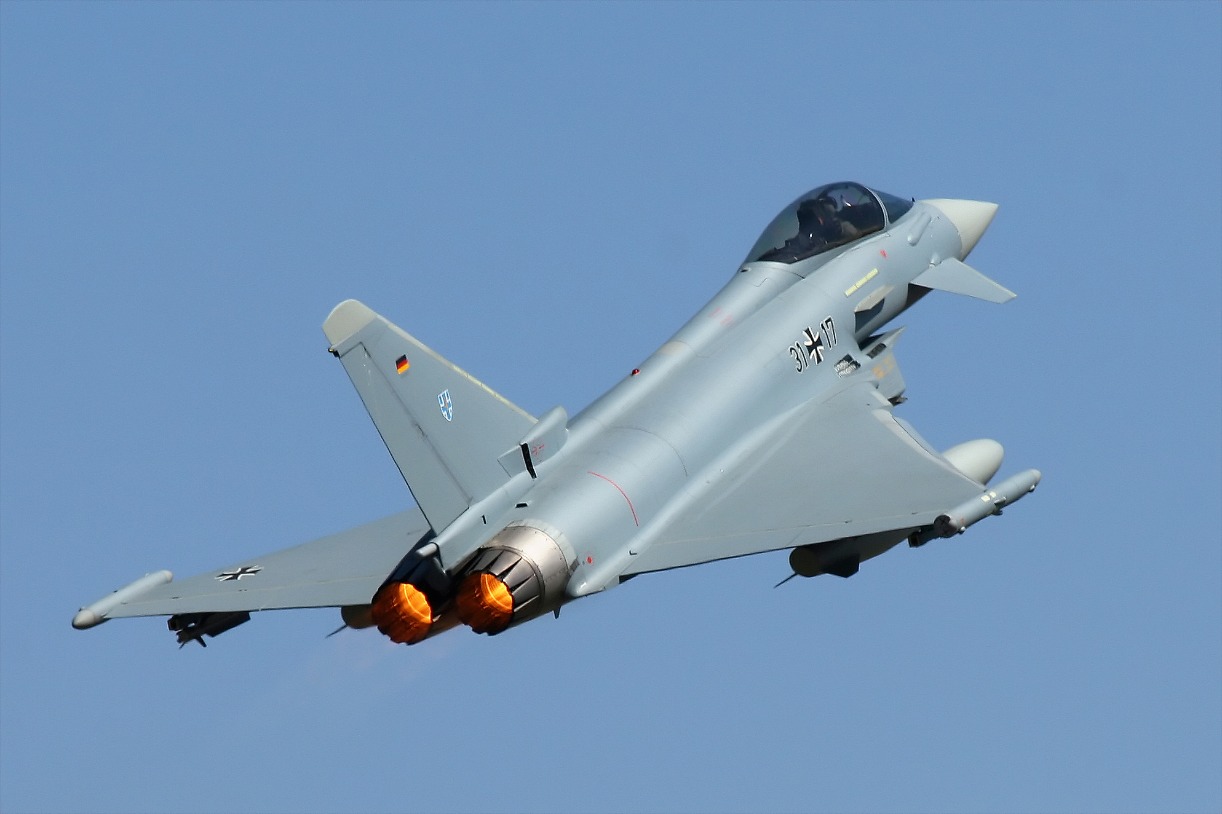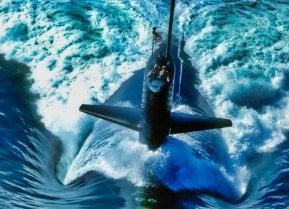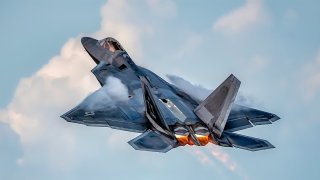Eurofighter Typhoon 'Shot Down' An F-22 Raptor Stealth Fighter
In 2012, German Eurofighter Typhoons outmaneuvered U.S. Air Force F-22 Raptors during Red Flag exercises, stirring debate over the Raptor’s air superiority. These mock dogfights took place within visual range, negating the F-22’s stealth and beyond-visual-range advantages.
This type of exercise is common in military training, however, and could be compared to offensive and defensive positions in scholastic wrestling. A neutral start in wrestling begins with both athletes on their feet – this would be like two fighters flying into an exercise in the same way they might in real life.
Starting in a defensive (or disadvantaged) position, on the other hand, is when one wrestler begins the period on their hands and knees, with their opponent next to them on one knee with an arm over their back (the advantage). In the case of these specific exercises, the F-22 played the role of the disadvantaged wrestler starting from its knees – playing to the Eurofighter’s strengths, rather than its own.
But like in wrestling, we should note that starting in a defensive or disadvantaged position isn’t an excuse for losing. It’s just part of the game.
Some allowances were also made for the Eurofighter before the fighting began. While the F-22 was carrying external fuel tanks that, to some extent, compromised both its aerobatic and stealth performance, the Eurofighter Typhoon that participated in one-on-one dogfights against the Raptor was allowed to fly not only without fuel tanks, but without any external munitions at all. This not only improved the Typhoon’s maneuverability, but it also couldn’t happen in a real fight lest the Eurofighter be left with nothing but its guns.
“There were two mornings where we flew against them 1v1. We pulled off all the tanks to get the most alpha [angle of attack]; the Eurofighter really is an animal with no tanks,” Germany’s Maj. Marc Gruene, one of the pilots who participated in the drills, explained.
How many of each fighter participated in these drills, what the rules of engagement were, and what the final kill ratios for each fighter were are all details that neither nation has disclosed, though there have been a number of claims made online. While these claims haven’t been confirmed, they all report more wins for the F-22 than the Eurofighter, but F-22s clearly took home some losses as well.
Today’s Eurofighter Typhoons come equipped with both a helmet-mounted targeting system to engage enemy fighters off-boresight (without aiming the nose of the aircraft at them), as well as the PIRATE infrared search and track (IRST) system that’s potentially capable of spotting stealth fighters at distances as great as 30 miles out. This would have been a significant advantage over the F-22 – which carries neither capability to date – but at the time of these dogfight exercises, these systems were still being rolled out to Germany’s Air Force, and the Typhoons that participated in the drills did not have them.

WHAT HAPPENED WHEN THE F-22 AND EUROFIGHTER SQUARED OFF?
According to the German pilots, once the fighting began, the F-22’s thrust-vector control (TVC) actually hindered the Raptor, rather than helping it when sparring in close quarters with the Typhoon.
“The key is to get as close as possible to the F-22 and stay there. They didn’t expect us to turn so aggressively,” Gruene told Combat Aircraft magazine back in 2012. “As soon as you get to the merge… the Typhoon doesn’t necessarily have to fear the F-22.”
(The Merge, for clarification’s sake, isn’t just the name of a great aviation newsletter. It’s also what fighter pilots call it when two fighters meet head-on in a close-quarters pass.)
TVC does allow a fighter to perform extreme maneuvers, but they come at a high cost. In a dogfight, airspeed is life, and the exotic displays TVC allows all scrub a great deal of it. When the F-22 uses its thrust-vectoring nozzles to turn on a dime, the jet is vulnerable until it can regain airspeed. If it doesn’t manage to score a kill immediately after performing such a maneuver, the Raptor becomes easy prey until its powerful pair of F-119-PW-100 turbofan engines can get all 70,000 pounds of fighter moving again.
Here’s how it was explained by an unnamed Eurofighter test pilot to Cenciotti:
“If you are ‘defensive’ and your aircraft has Thrust Vectoring, you can possibly outturn your enemy, but that most likely won’t prove to be a great idea: an energy fighter like the Typhoon will conveniently ‘use the vertical’ to retain energy and aggressively reposition for a missile or gun shot. Also the subsequent acceleration will be extremely time (and fuel) consuming, giving your opponent the opportunity to tail chase you forever, exploiting all its short range weapon array.”
But even on the offensive, using TVC to quickly orient the nose of your fighter toward the enemy isn’t always a good idea either. Because aggressive maneuvers strip the fighter of energy, you may score a kill against the opponent in front of you, but you’re left vulnerable to any others nearby. This inherent issue with thrust vectoring combat tactics is really why no other American fighters are equipped with it, and in fact, Raptor pilots themselves will tell you that the real benefit of TVC in their aircraft is maintaining a degree of maneuverability while flying at a high angle of attack when control surfaces aren’t as effective, rather than performing air show maneuvers in a dogfight.
AT LEAST TWO EUROFIGHTERS SCORED KILLS AGAINST F-22S… BUT THERE’S MORE TO THIS STORY
We know for sure that at least some (likely two) Eurofighters actually scored notional kills against their F-22 opponents in these drills. That story was quickly picked up by news outlets around the world, eager for a story about America’s expensive Raptor failing to live up to expectations.
What we don’t know, however, is how many kills Raptors scored against Typhoons, though it seems clear from official statements that the number was definitely not zero. In other words, the story wasn’t that Raptors consistently lost to Eurofighters, but rather, that sometimes they did.
So what does that mean, exactly?
When aviation buffs start squaring off in the comments sections below articles and videos about their favorite (or least favorite) fighter platforms, it usually doesn’t take long for the discourse to stop sounding like a well-informed debate and start sounding like 3rd graders arguing about whose dad can beat up who’s. The complex context of air combat gives way to oversimplification and hyperbole until everything devolves into ad hominem attacks and seemingly made-up and uncitable statistics.
What can I say? Airplane folks go hard.
There are, however, reasonable arguments to be made from both sides of this debate — which I’ll try to capture below:
The Raptor-fan argument
Those in the Raptor camp will contend that exercises like these, with their contrived circumstances and intentionally one-sided rules of engagement may be good for training, but they’re a poor measure of a fighter’s actual performance in the absence of broader context. The very nature of these exercises set out to put the Raptor at a disadvantage, eliminating the platform’s greatest strengths – its stealth and beyond-visual range capabilities, in favor of an old-fashioned shoot-out the likes of which haven’t been seen at scale since the Vietnam War. According to media reports, the F-22 “decimated” the Typhoon when able to engage from beyond visual range because it didn’t have to fly with one wing tied behind its back.
In a real fight, the F-22 would likely be aware of the Typhoon’s presence well before the Typhoon was aware of it, and even if the Eurofighter and pilot proved too quick on the stick to be taken out with an AMRAAM at long distance, the Raptor could use its superior situational awareness and low observability to close in on its European foe from an advantageous position, greatly improving its chances of success.
And perhaps most importantly of all, Raptor fans will argue that Germany was bragging about scoring a few kills against the Raptor… but they never once claimed that the Eurofighter won more sparring matches than the Raptor did. They simply claimed that it won some, and that was with a number of distinct advantages handed to them.
The fact of the matter is, the headline-grabbing story wasn’t about Eurofighters dominating the F-22… It was about two of them managing to score wins at all against an aircraft many think of as invincible.
The Typhoon-fan argument
Those in the Eurofighter Typhoon’s camp, on the other hand, will argue that these exercises, like real combat, aren’t about being fair. The Eurofighter’s ability to stand and scrap with the Raptor in close quarters is proof positive that the Typhoon is capable of competing with the most advanced (and expensive) fighters on the planet when it comes to close-quarters air combat.
And that, combined with its improved avionics and beyond-visual range capabilities that have manifested since that interaction, make the Eurofighter Typhoon one of the best pound-for-pound fighters anywhere on the planet.
Its foreign-sales price is, after all, right around $124 million – which is an incredible bargain compared to the estimated $400 million or so per Raptor, at least, when you include its research and development costs in each F-22’s price tag.


